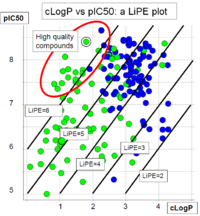Lipophilic efficiency

Lipophilic efficiency is a big word that means how good a molecule can stick to fats. You know how oil and water don't mix? Well, some molecules like to stick to oils and fats more than others. This is important because many important things in our bodies, like cells and enzymes, are surrounded by fats. So if we want to make a medicine that can help us, it needs to be able to stick to these fats.
Scientists use something called Lipophilic Efficiency to figure out how well a molecule can stick to fats. They take a molecule and measure how well it can stick to fats, and then they divide that number by how big the molecule is. This tells them how good the molecule is at sticking to fats, compared to how big it is.
Imagine you and your friend are trying to stick stickers onto a piece of paper. You have a really tiny sticker that sticks really well, and your friend has a big sticker that doesn't stick as well. If you count how many stickers you both put on the paper, you might think your friend did a better job because they used a bigger sticker. But if you divide how well each sticker stuck by how big it was, you would see that your tiny sticker was actually more efficient at sticking.
So lipophilic efficiency is like measuring how well stickers stick to paper, but for molecules sticking to fats. Scientists use it to figure out which molecules would be the best medicines to help us.
Scientists use something called Lipophilic Efficiency to figure out how well a molecule can stick to fats. They take a molecule and measure how well it can stick to fats, and then they divide that number by how big the molecule is. This tells them how good the molecule is at sticking to fats, compared to how big it is.
Imagine you and your friend are trying to stick stickers onto a piece of paper. You have a really tiny sticker that sticks really well, and your friend has a big sticker that doesn't stick as well. If you count how many stickers you both put on the paper, you might think your friend did a better job because they used a bigger sticker. But if you divide how well each sticker stuck by how big it was, you would see that your tiny sticker was actually more efficient at sticking.
So lipophilic efficiency is like measuring how well stickers stick to paper, but for molecules sticking to fats. Scientists use it to figure out which molecules would be the best medicines to help us.
